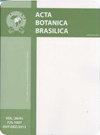Floristic characterization and pollen morphology of plants visited by Apis mellifera L. in caatinga areas in Bahia, Brazil
IF 1.1
4区 生物学
Q4 PLANT SCIENCES
引用次数: 0
Abstract
The aim of this study was to identify plant species visited by Apis mellifera L. in honey producing areas with typical Caatinga vegetation in the State of Bahia, as well as morphologically characterize pollen grains of the most representative species. Flowering specimens were collected from both areas, herborized, identified and deposited at the HUNEB herbarium. Analyses of floristic similarities were performed between eleven municipalities close to the study areas. Pollen was collected from all specimens, acetolyzed, measured, statistically analyzed, morphologically described, and photographed in light microscopy. Of the total of species recorded, 67.46 % were regarded as having beekeeping importance, with the richest botanical families being Fabaceae, Malvaceae and Asteraceae. Additionally, 37.5 % of the recorded species were herbs. The analyzed municipalities showed 84 % of floristic similarity. Of the total species recorded with visits by A. mellifera , 25.52 % had their pollen grains already described in the literature as monads, tetrads and polyads; isopolar, apolar and heteropolar; and mostly prolate spheroidal shape. Sizes varied from small to large, and the amb circular was predominant. The exine ornamentation was greatly diversified, varying from psilate to echinate. The obtained data corroborate the palynological knowledge of plants regarded as having beekeeping importance within the Caatinga.巴西巴伊亚州卡廷加地区蜜蜂到访植物区系特征及花粉形态
本文章由计算机程序翻译,如有差异,请以英文原文为准。
求助全文
约1分钟内获得全文
求助全文
来源期刊

Acta Botanica Brasilica
PLANT SCIENCES-
CiteScore
2.30
自引率
9.10%
发文量
32
审稿时长
6-12 weeks
期刊介绍:
Experimental, theoretical and applied papers on all aspects of plant (including algae) and fungi biology are welcome. The submitted manuscript or its essential content must not have been published previously or be under consideration for publication elsewhere. Contributions should be substantial, written in high-quality English and show general interest. We expect that the submitted manuscript presents a great novelty in Botany, and this should attract a wide audience. Considering this, case studies are only considered if the narrative and implications are provided to be of general interest. Thus, manuscripts that report aspects of local interest are discouraged unless the implications of the findings are wide-reaching. Manuscripts with agronomic subjects are expected to contain a substantial amount of basic plant biology. Please see below some details for specific area.
 求助内容:
求助内容: 应助结果提醒方式:
应助结果提醒方式:


